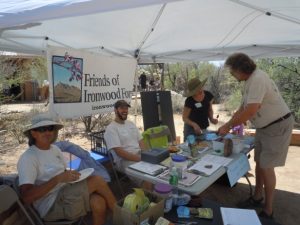Source: Joshua Bowling, The Republic/azcentral.com, October 18, 2017
Arizona Centennial
Arizona Conservationists: Save Our National Monuments
Source: By William Thornton and Tom Hanagan, Special to the Arizona Daily Star, June 4, 2017
The president’s executive order to review national monuments could recommend downsizing or abolishing monuments over 100,000 acres designated since 1996. A brief history of the Antiquities Act and case study from Ironwood Forest in our own backyard might clear up some misconceptions.
Signed into law by Theodore Roosevelt on June 8, 1906, the Antiquities Act gives the president authority to, by proclamation, create national monuments from public lands to protect significant natural, cultural or scientific features. The law was necessary after decades of looting and desecration at Native American sites such as Chaco Canyon. Roosevelt went on to designate 18 national monuments. Grand Canyon and Petrified Forest in Arizona have been upgraded to National Park status.
National Monuments are owned by the American people. Each of Roosevelt’s successors, Democrat or  Republican, has used the Antiquities Act to protect lands in the public domain. Opponents of new national monuments have characterized the process as “arbitrary, capricious” and subject to manipulation by “tree huggers” who draw lines on a map, and before you know it, the public is “locked out” and economic activity comes to a screeching halt.
Republican, has used the Antiquities Act to protect lands in the public domain. Opponents of new national monuments have characterized the process as “arbitrary, capricious” and subject to manipulation by “tree huggers” who draw lines on a map, and before you know it, the public is “locked out” and economic activity comes to a screeching halt.
In reality a monument proposal must make a compelling case that the area contains natural or cultural features worthy of protection. For Ironwood Forest these features include: the only surviving indigenous herd of desert bighorn sheep in the Tucson area, the largest stand of desert ironwood trees, numerous archaeological sites and critical habitat for an endangered cactus.
What does monument designation mean for Ironwood Forest?
 Monument land has benefited from thousands of hours of hands-on work by hundreds of volunteers from the Friends of Ironwood Forest, Arizona Native Plant Society, Bighorn Sheep Society, Arizona-Sonora Desert Museum, Sierra Club and many others. Invasive buffelgrass is one of the most serious threats to our Sonoran Desert. A coordinated effort to control it is making progress, but it may not have been possible without monument designation.
Monument land has benefited from thousands of hours of hands-on work by hundreds of volunteers from the Friends of Ironwood Forest, Arizona Native Plant Society, Bighorn Sheep Society, Arizona-Sonora Desert Museum, Sierra Club and many others. Invasive buffelgrass is one of the most serious threats to our Sonoran Desert. A coordinated effort to control it is making progress, but it may not have been possible without monument designation.
Free access is available with restrictions deemed necessary to protect the resource. Hunting is permitted subject to regulation by the Arizona Department of Game and Fish. Privately owned parcels within the monument remain available for use subject to local zoning laws. When funds are available, land may be purchased from willing sellers. Land has been donated, but the BLM cannot seize or force the sale of private land.
Historically, mining and ranching have been major economic activities in the area. Grazing leases on monument land remain in force and are renewable. The Pioneer Materials quarry continues to operate.
Outdoor recreation is big business in Arizona, bringing $10.6 billion in consumer spending, $787 million in state and local tax revenue, and supporting 104,000 Arizona jobs, according to the Outdoor Industry Association. Parks and monuments are a big part of the picture.
National monuments do not belong to the president or Congress. They are our lands and heritage but will remain so only if we speak up. Comments may be submitted through monumentsforall.org or regulations.gov. Deadline is July 10. Also, please contact Senator Flake and Senator McCain and your congressperson and respectfully request that they stand up for our monuments.
State should begin its 2nd century by preserving series of landmarks, former Phoenix mayor says: Arizona Heritage Alliance is looking for ways to restore AZ Heritage Fund
[Source: Bonnie Bariola, Florence Reminder] –The Arizona Heritage Alliance is a nonprofit organization that was formed in 1992 for the purpose of working to prevent the Arizona State Legislature from taking or eliminating the Heritage Fund. Unfortunately during difficult economic times, in 2009 the Legislature took away the Arizona State Parks portion of the fund and in 2010 completely eliminated the language from the Arizona Revised Statutes. Fortunately the Arizona Game and Fish Commission’s $10 million portion of the Heritage Fund remains intact.
The Alliance continues to meet, with its goal now being to get the Arizona State Parks portion of the Heritage Fund restored. At its June 25th meeting, the board members discussed several methods for funding a Heritage Fund as well as possible methods for restoration of the fund.
2nd Century Initiative
Former Phoenix Mayor John Driggs was guest speaker at the meeting presenting a project he is spearheading. Former Mayor Driggs chaired the Arizona Centennial Committee and in this capacity determined the state capitol and other state buildings should be rehabilitated as a showcase for not only Arizona but the entire United States.
He is promoting the Arizona Second Century Initiative that would be the rehabilitation of the Government Mall extending from the State Capitol to Hunt’s Tomb in Papago Park. In addition to the Arizona State Capitol and Hunts Tomb it would include the El Zaribah Shrine Building, Carnegie Library, Tovrea Castle and Grounds, National Guard Arsenal, the Arizona History Museum, the Sandra Day O’Connor house, and the Eisendrath House.
Driggs suggests the following “Arizona’s second century initiative would be ‘Building Harmony’ by applying community values recalled by our landmarks in shaping plans for the future.” He further says “Arizona would launch its second century by preparing several iconic venues to reflect the state’s cultural heritage. Respectfully rehabilitated landmark buildings will provide a lasting legacy for Arizona’s second century.”
He suggests the first phase of this project should be the complete rehabilitation of the El Zaribah Shrine Building. He would like to find private donors for this purpose and is hoping such donors will come forward. Once complete this building would provide a multipurpose assembly facility serving as a public forum and special events venue for state and local government.
Plans for the Carnegie Library would be to provide space for a special civics education center to promote civil dialogue and civic action. This new use could complement the existing uses in the library and correlate to the goals of the O’Connor House which is located in Papago Park.
It is his dream that Tovrea Castle and Gardens, owned by the city of Phoenix, could become the first Arizona State Park to be located in Maricopa County. It would be a joint venture with the city of Phoenix as owner with the Arizona State Parks system becoming a partner. Opened to the public in 2012, reservations for tours have far exceeded expectations and are booked months in advance. The Tovrea Carraro Society provides thousands of volunteer hours by docents leading the tours and handling all aspects of the daily operations of the castle.
Located in Papago Park, the O’Connor House, home of the first woman to serve as a United States Supreme Court Justice, was moved from its original site in Paradise Valley to Tempe. It is now known as “The O’Connor House and Center for Civic Discourse” and provides a venue “for people and organizations to come together and resolve conflicts or disagreements peacefully.”
Hunt’s Tomb contains the remains of Arizona’s first governor, his wife and five other family members. Elected in 1912 when Arizona became a state, he ended his seventh term in 1933. After a visit to Egypt, he and his wife became fascinated with its pyramids which resulted in him seeking permission from the legislature to build a pyramid tomb. Permission was granted and the tomb was built in its current site.
So what does all this have to do with the Arizona Heritage Alliance? If the Alliance can be successful in getting the Heritage Fund Grant Program reinstated, it would provide seed monies for the rehabilitation of many of these historic buildings. If Heritage Fund Grants were available, it would be easier to obtain private donations to complete the rehabilitation of these valuable historic buildings and resources.
Small cities struggle with historic preservation efforts
[Source: John Yantis, AZ Republic] – The wrecking ball often swings faster in smaller cities trying to save history, preservationists and local leaders say. Money, know-how, constantly changing priorities and new residents with shallow roots in the community often hinder efforts to protect historic architecture and cultural sites. The dilemma leaves longtime residents disappointed and frustrates efforts to save local landmarks.
In June, former students failed to save an auditorium-turned gymnasium in Litchfield Park. Constructed in 1928, the gym was a reminder of the city’s early days. A month later, Buckeye officials voted to demolish a cotton gin that was also built in 1928. After the decision, a town councilman wondered aloud why Buckeye bothers to advertise its historic past. “The gin is just a rusty building,” said Councilman Robert Garza, a fifth-generation native of Buckeye. “But it is part of our heritage.”
Preservation can present challenges in larger cities, too. In Mesa, organized efforts to save historic sites began in the mid-1990s, but advocates said they only came after the city lost numerous noteworthy buildings, including a social hall, park and school.
Impediments to saving history in smaller cities are usually more acute. They often start too late. “It can happen at all different levels, but I think small communities haven’t spent a lot (of) time inventorying,” said James Garrison, state historic-preservation officer.
“They’re interested in growth and new things and attracting businesses and doing all these things and often don’t take a look around at what might fit a new use or be available for adaptive reuse.” Adaptive reuse is a process that allows older buildings to be used for new purposes while retaining their historic features.
Many large cities have preservation officers and commissions that allow experts to plan and look for properties that could become endangered, Garrison said. Smaller towns’ historic sites often go vacant, which escalates the cost to fix them up. Buildings left empty deteriorate quickly and are often vandalized. Also, often there is little practical discussion about what they will be used for. Every property can’t become a museum, but these sites still need an active life in the community, Garrison said.
Financial challenges – Preservation efforts in Arizona were recently complicated after a state-funding source dried up. In 2010, the governor and state Legislature stripped a portion of Arizona’s Heritage Fund that provided $1.5 million in grants for cities to find, preserve, stabilize and rehabilitate buildings and other historic sites. The fund was made up of lottery proceeds approved by voters in 1990.
The Arizona Heritage Alliance and others are working to restore the fund, which is administered by the Arizona State Parks Board. The Arizona Preservation Foundation, a group of volunteer preservation advocates, did not gather enough signatures to get the issue on the November ballot. They plan to get the issue on the ballot in 2014.
As public money for preservation becomes more scarce, some cities have unsuccessfully tried to find private financing. In Goodyear, a years-long effort to restore the Litchfield Train Station is taking a new direction after backers had difficulty raising enough money through raffles and car and train shows. Members of the city’s Centennial Commission decided in May to form a non-profit foundation, said Wally Campbell, a city councilwoman who serves on the board. Supporters hope the foundation will qualify for grants. Someday, foundation officials hope it will be part of a train park for children. “We’re excited about it, but we’re moving forward slowly,” Campbell said. The 1,900-square-foot station was built in the 1920s by the Southern Pacific Railroad. In 2009, the city moved the depot 3 miles from its original location, to an area near the intersection of Cotton Lane and Maricopa 85.
Ever-changing plans – In Buckeye, evolving city plans have frustrated historic-preservation efforts. For years, informal town plans called for turning the Eastman Gin into a museum and downtown gateway to showcase the area’s agricultural heritage. Town officials spent more than $2 million to buy the gin and surrounding property. In the end, renovating the landmark, which was once used to separate cotton from its seeds, was too costly. Demolition is expected to begin in early September. For Garza, it was the latest example of shifting priorities. “It’s hard because Buckeye went through a giant boom, and we had a big influx of people from outside,” he said. “They didn’t necessarily see what we saw in our community, in our history, in our culture.”
Successful saves – Jim McPherson, president of the Arizona Preservation Foundation, says there is greater awareness about the importance of historic preservation in smaller cities. Officials and the public are more focused on sustainability and adapting buildings to be reused, he said. Old Main, a 90-year-old vacant building on Peoria High’s campus, will be saved. About $1.6 million will be spent to save the building.
Phoenix has used bond money to renovate many historic structures, McPherson said.
And earlier this month, Litchfield Park struck a deal with the school district that will ensure the protection of a mission-style church built in the early 1920s. Unfortunately, some historic sites in small towns can’t be saved, McPherson said. “We hurt every time that happens because that’s one more strike against our heritage in a state that’s relatively new,” McPherson said.


You must be logged in to post a comment.